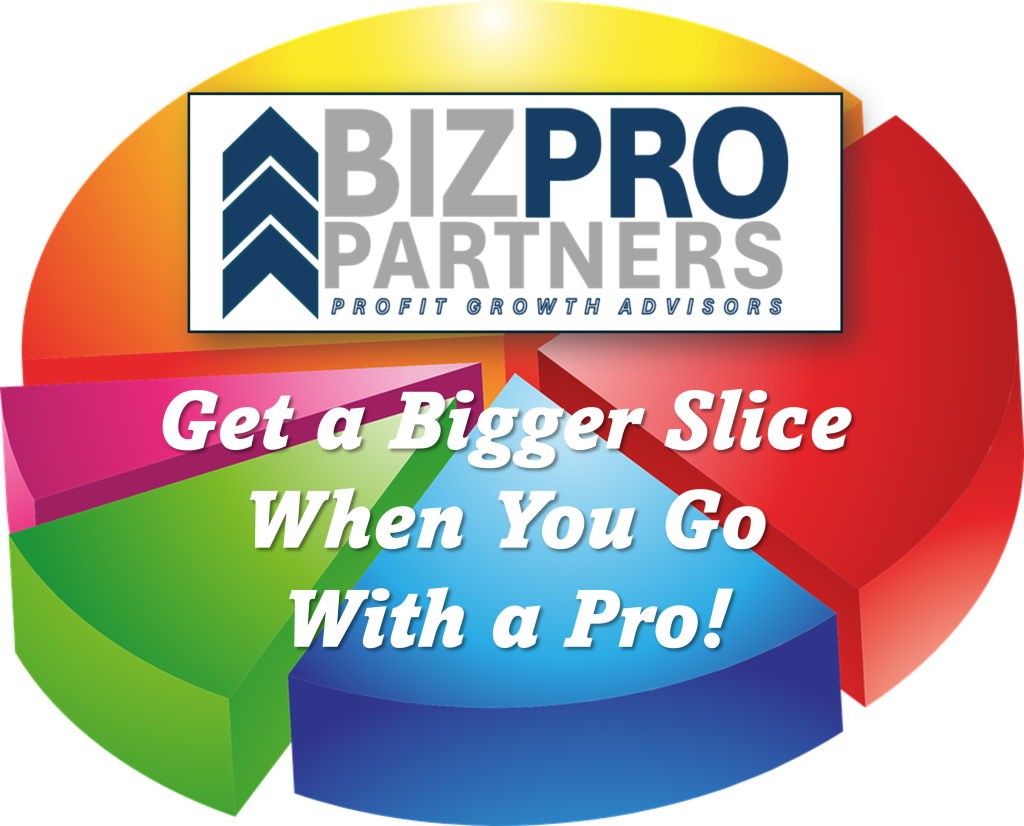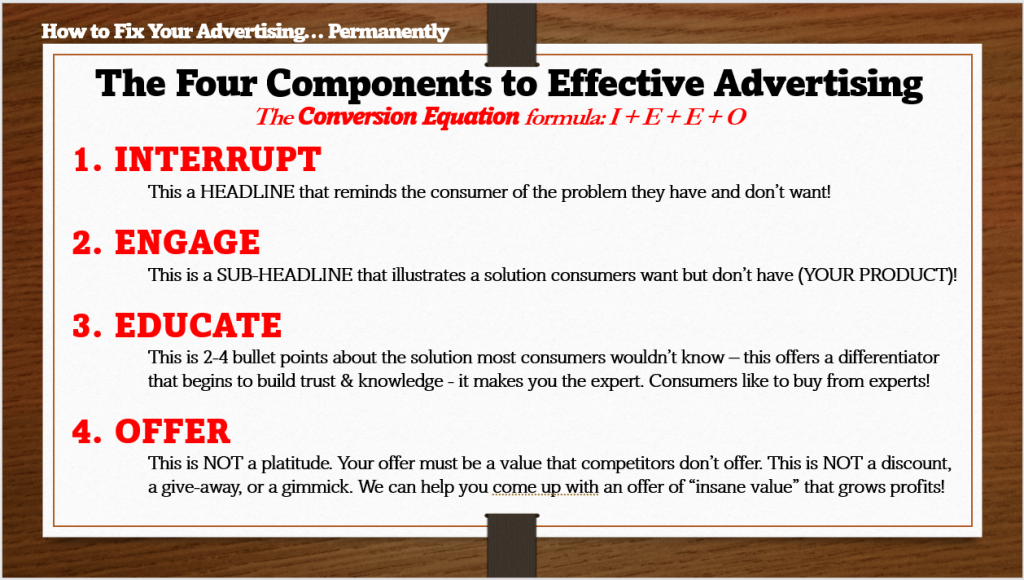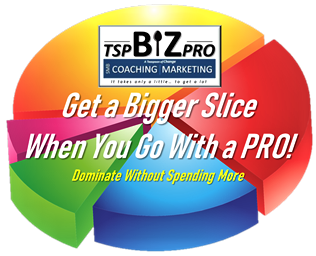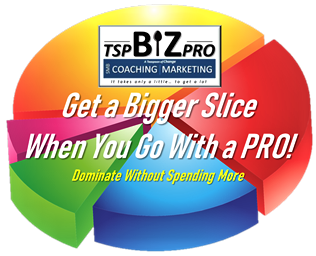What’s a compelling offer?
This is a question I get a lot when my clients get to this part of their Virtual MBA curriculum included in our online Business Academy. While it’s all explained in their classes, it’s typically the first time they’ve heard this concept. Of course, they know what it means – it’s pretty straightforward. They simply need some examples to understand what it is and what it’s NOT.
Let’s be clear: a compelling offer is NOT what you see and hear in typical advertising. It’s NOT a discount, it’s NOT a sale, it’s NOT “free estimates”, it’s NOT “family owned”, or “call today” or “best selection”, “greatest volume”, “lowest prices”, or any of the typical platitudes you see and hear in your daily bombardment of traditional advertising.
No, a compelling offer is, well, compelling. It means an offer that compels people in market for what you sell to take action. It’s that simple. It’s the competitive aspect of marketing that makes your offer the “no-brainer” solution to consumer buying issues in your genre.

But devising a compelling offer is not always so simple. What usually is involved in a compelling offer is knowledge and creative thinking. The knowledge generally comes from knowing your costs, Yep, you must know what your TOTAL cost-of-sale is. That means not just what you paid for it plus your mark-up, but what you paid for it, your costs included in any sales commission, administrative costs, and even fixed costs like building lease payments, insurance, and all the associated costs of running your business.
If you’re not factoring in all your variable costs plus your fixed costs and plugging your margin into the total number, then your profit isn’t what you think it is. That will affect your cashflow negatively. That’s why it’s not uncommon for my Advisors to hear “How come my CPA says I’ve got a profitable business, yet I’ve got no cash?”
Figuring out how to get a true profit margin is in another post. For now, we’ll assume you’ve got your costs and profit aligned with your products and/or service margins. So, you’re now ready to continue building your compelling offer(s).
Next comes vendor negotiations. Can you get a discount for buying bulk? How about guaranteeing a certain volume or similar for a reduced cost? Ask your vendors. In today’s world of escalating prices, vendors are keen to keep the business they have, and many will provide some sort of deal just for asking. Especially if you tell them you are revisiting supplier agreements in an effort to cut costs. Most will give you a 10% discount right off the top.
Think about that: if you’re spending $25,000 annually with a supplier, a 10% discount is saving you $2,500. While that may not seem like a lot, that is 100% profit in your pocket. If you’ve got a 10% net/net margin, that 10% supplier discount is 10x your profit margin. That means you’d have to sell $25,000 worth of products or services to put $2,500 in the bank. You just did that with one vendor telephone call.
Can you think of some things you could do with an extra $2,500? Do that with all your vendors and you might be surprised at what suppliers will offer to keep your business.
“It never occurred to me to look at upstream and downstream vendors to build a compelling offer my competitors wouldn’t know how to match. I got calls from a couple of them wanting to know if I was trying to run them out of business. This was the easiest improvement I ever made in my sales effort, and it didn’t cost me an extra dollar to do it.”
John D. Weber
You might also find some surprises that lead to compelling offers for your business. Here’s an example:
A sunroom builder and all of his competitors buy the same products from the same wholesaler. They all build the exact same sunroom and sell it for the exact same price. There is absolutely no difference in quality, materials, price, or craftmanship. So, the builder is telling me “You can’t help me. There is no difference to promote.”
But all is not as it seems. I asked the builder, “So, what is the next thing people buy after buying a sunroom?” The builder just looked at me. “Huh? What do you mean?”
“Well, people don’t sit on the floor in an empty room, do they?”
Through the Business Academy training, the builder learned techniques for negotiating a better deal than his competitors. He also learned through the Academy how to negotiate “upstream” and “downstream” products and services. That means working with vendors that supply products or services that naturally fit before or after the main purchase.
The builder negotiated with a furniture wholesaler to feature five (5) different ensembles of furniture – in fact, he obtained 15 pieces of indoor/outdoor furniture for $1,100 so he could sell his sunrooms fully furnished for the same price as his competitors’ empty rooms. After that, he determined he could wire the rooms for surround sound for nearly nothing (they were already building the walls & ceiling, so wiring was easy). Then he added in a wall-mounted 55″ flat panel TV and a ceiling fan for a total of another $175 per room.
So, for just under $1,300 in margin, he could sell his fully furnished sunrooms for the same price as his competitors’ bare rooms. Did he take a little less margin? He certainly did – but he more than made up for it on a lot more sales volume. His increase in market-share overwhelmingly made up for the little less margin he took to dominate the business.
His compelling offer?
“Buy our sunroom fully furnished with your choice of 5 furniture ensembles, big screen TV, surround sound, and ceiling fan for the same price as their empty room.”
He showed pictures of his finished room fully furnished versus their empty room with the headline, “Not all sunroom builders are alike!”. So, if you’re in the market for a sunroom, which would you rather have?

Now THAT’S a compelling offer. Think like a consumer. If you were in market for a sunroom, which one would you choose?
This works for ANY business.
If you put your mind to it, maybe do some negotiating, you too can come up with an offer that’s more compelling than your competitors and thus increase your sales volume, market-share, and PROFITABILITY.

563.293.5930
With our online Business Academy any small-to-medium-sized business owner can learn how to
OUTSMART instead of OUTSPEND
The Conversion Equation
I’m going to make this somewhat complicated subject simple – and the explanation brief so you can get on with business. But it’s important for you to understand. Using the Conversion Equation (below) in all your marketing is the difference between advertising and consistently effective advertising. No one locally is going to use this or educate you on it because they don’t know it themselves. This isn’t taught in marketing school, business school or by ad agencies or media companies.
“I know half my advertising is wasted. Problem is, I don’t know which half.”
– John Wannamaker | Philadelphia
(the father of modern department store business model)
The Conversion Equation was developed from 35 years of on-the-street marketing with small to medium sized business owners. It’s not used by Madison Avenue, Michigan Avenue, or Santa Monica Boulevard ad agencies because their clients are primarily branding – not direct response like you want if you want to sell your products and services. You don’t have to take my word for it. Try it. What have you got to lose?

If you need more help in how to fully leverage the Conversion Equation, give us a call at 563-293-5930 or click here to schedule a 15-minute conversation online with one of our Senior Advisors. The call is free.

Advertising Vs Marketing
Across 35-years of guiding small business owners, I’ve found most owners use the terms “advertising” and “marketing” interchangeably as if they mean the same thing. They don’t: Marketing is a strategy – advertising is a tactic that is typically used in marketing.

Advertising Vs Marketing: Strategy sounds like a lot of work, where advertising is easy. Anyone can sell you advertising. In fact, that’s part of the problem: too many “less-than-knowledgeable” sources make it confusing and chaotic. Firms like media companies do not require any experience from reps to sell advertising. You see, they sell audience size and “likes” on Facebook. They never talk about getting the message right. Think of trying to sell your dog products to people that don’t own dogs. So, if the audience is wrong, all the advertising in the world isn’t going to help. About the only thing you can do here is change your message to target “friends” of dog owners to have a chance at making sales.
Most owners say they want advertising. They want exposure on the latest social media. They want updated websites. They want SEO. They want all the things they’ve heard about. Worst of all, unfortunately, are the one that want to “get their name out there”. They’re doomed to spend a lot of money with little to show for it. What I’ve found is most owners have no strategy at all. They spend money and “hope for the best”.
So, what’s a strategy? Marketing, on the other hand, makes all your tactics (i.e.; advertising, website, audience composition/segmentation, data, campaigns, leads, conversions) work together with the end strategy of getting more consistent results by delivering the right message to the right people at the right time with a process of converting them into paying customers. It makes all the difference.
If you’re going to advertise without a strategy, at least get the message right by ensuring you have the four components necessary in all your marketing. Here’s the formula: I + E + E + O (Interrupt + Engage + Educate + Offer). And make sure you have a COMPELLING OFFER.
Compelling Offer: This is where advertising typically fails miserably. Your offer needs to be compelling. Platitudes like “biggest, best, most, family owned, in business since” aren’t compelling. Neither is “10% off, free estimates, sale today only, or call today”. A compelling offer emphasizes consumer benefits your competitors don’t with a low-risk call-to-action. It’s easier than it sounds. We do this every day.
What you need to know: Most business owners don’t want to be “marketing gurus” – I don’t blame them… it’s not why they got into business. I’m here to tell you that you DON’T need to be. But, you do need to know the basics. There are only a few and they’re not complicated. Get the basics down and not only will sales, profit, and ROI improve, but you’ll NEVER need advice from advertising sales reps. You’ll know exactly how to build effective ad campaigns (or ensure someone else builds them properly), you’ll never have to be concerned with audience size, you’ll never waste ad dollars. You’ll be in 100% control even if you assign the work to others.
The goal here is NOT to make you a marketing guru – the goal is to build the business of your dreams.
Do You Have a $25,000+ Package to Sell?
Strategy eats tactics for breakfast… and tactics put runs on the board (money in the bank) quickly – Karl Bryan
Whether you like it or not, every business sells – every business. If you don’t sell something (or think you don’t), you don’t have a business. What you have is an expensive and time-consuming hobby.
So, based on the fact we all are in the sales business, do you have a $25,000 item or package you sell?
Every time I ask that question, I get silence, then an excuse. “I’m a CPA”, or “I’m a florist” or whatever. It really doesn’t matter if you’re a butcher, baker, or candlestick maker, you need a $25k, $50k, or, depending on your business, a $100,000 package of services and/or items to sell.
Will you sell a lot of them? Probably not. But, what you will sell a lot of will be your most profitable items under that category.
When my son was a little boy, he taught me an Elmo song from Sesame Street. Elmo was half-way up the stairs. Elmo acknowledged that he wasn’t at the bottom and he wasn’t at the top. Why, because “in the middle” is where most people feel comfortable. So was Elmo.
So, what does this story have to do with a $25,000 package? Plenty.
You see, most every business owner knows the easiest sale is to a current customer. Getting more transactions from current clients is a way to skyrocket your profit. Yet, most business owners make no discernable effort to do so.
Take the Florist for example: The florist sees most men only a few times per year… wife/gf’s birthday, Valentines Day, Anniversary, and Mother’s Day. Yet, the Florist typically makes a sale on only one of those occasions, not all four.
What would happen if that Florist offered a VIP package that automatically sent flowers to that special someone three or four times per year covering all the dates important to her (plus maybe mail or email a signed card or sent a smaller bouquet AUTOMATICALLY for other occasions so it’s never late or forgotten) but the guy paid only once – annually? Or, he could make 4 quarterly payments, hitting his American Express automatically.
Not every guy would buy it, but that’s not the point. Say two out of ten agreed to participate in the Florist’s new VIP Plan. That’s 2 or 3, maybe 4, more transactions per year with no marketing costs. What if the Florist saw 100 men walk-in to the flower shop on each one of those special occasions and closed 20 on on a VIP package each holiday?
That’s 80 new sales each year. So, 200% to 500% increase in sales simply by being prepared and asking.
Say, hypothetically, the Florist’s profit margin was $300 on each package. That’s $300 x 80 new VIP packages = $24,000 annually and ALL profit. Not huge money, but not bad simply for putting some thought into their clients situation.
Now, realistically, most Florists are not going to sell $25,000 to men, but they certainly could to companies. Maybe not sentimental occasions (or maybe they could – who knows?), but companies have board meetings, staff celebrations, company milestones, etc.
Let’s say you’re an accountant. An accountant could easily sell $25,000 packages of their services. Individuals and small business owners see you to prepare their taxes. For small business owners, do you provide advisory services just once per year? Of course you don’t.
But, if you packaged in quarterly reviews, financial planning, tax assessments, financial book archiving, benefit plan reviews, and all the necessary and advisable items a CPA needs to deal with to keep clients compliant and all done in a neat, calendared package, you think business owners would buy it? I know they would. We help them with it all the time.
You see, the point is, a lot of your customers don’t know what they need or that you offer it. Bundling products or services that naturally make sense for the client also make sense for your business and your profit.
I’m sure you get the point. All it takes is some thought and a little planning. When you sell your first four $25,000 packages and put a newfound $100k on the books, you’ll not only be amazed as to how easy it really was, you’ll wonder out-loud “How come I didn’t do this sooner”?
Let us know if you need some help developing ideas! Good luck.
How to make your advertising work 3x better (in just 2 minutes)
Advertising – it’s the one area most business owners think alike. They believe advertising is a necessary evil. They think it’s expensive, wasteful, and they are completely at a loss when it comes to exactly what makes advertising work. And they believe it’s about the only thing they can do to grow their business.
Most business owners are correct about their advertising being expensive and wasteful. But, they’re wrong about advertising as the primary way to grow a business.
They also get no help from their local “experts”… media companies and advertising agencies. Here’s why: media companies (your local TV, radio, print, digital, etc.) are not marketing experts. They barely know more than the average SMB owner. That’s not meant to “bash” media people. It’s simply the fact that local media companies are not marketing firms – they are sales organizations. Period.
You see, what they sell are message delivery systems. Just like the US Postal Service, except the USPS actually knows to whom they’re delivering your message. Local media doesn’t have a clue. Their audience is whatever it is at the time. They build ads for one purpose: to have something to deliver!
While it would be reasonable to assume advertising sales reps know something about advertising, most don’t know as much as you might think they should.
It’s not the reps fault. They are paid to sell. They are trained by their employer to sell. To keep their job, they must sell. Unless your rep takes it upon him/herself to learn marketing on their own time and their own dollar, they won’t know anymore about advertising than you. And, take it from me, their employer y won’t spend one minute teaching marketing.
How do I know this? Well, I spent about 30 years in media. From being a lowly, on-the-street Account Executive, to sales manager, then General Sales Manager, to Director of Sales, all the way up the management ladder to Corporate Director of National Advertising for two top media companies.
I’ve worked in television, radio, newspaper, cable, and digital specifically for the experience – to see how it’s really done. No theory or industry propaganda here. But, this is not about me. I tell you this only so you can believe that I know what I’m talking about.
Media reps are taught how to sell, along with a mandate to increase their sales year-over-year… even if it doesn’t help their clients. To make things worse, they are commission salespeople. The more they sell, the more they earn. Again, regardless of any of the advertising produces results for the advertiser. So, their advice is inherently biased towards their own media.
Most media outlets do NOT require their reps to have a marketing degree. Sure, they’d prefer it, but it’s not required. The people they hire, while good people who have no ill intent, are trained in sales, not marketing. They have one job and that is to SELL their ad inventory to anyone who’ll buy it.
Therefore, they don’t know what they don’t know about marketing. And what they don’t know is costing you… big time.
So, in that context, I ask my clients if they would ever allow their postal carrier to design their direct mail piece. Of course, they all say “no”. When I ask them why, almost universally they say something to the effect of “because they have no understanding of marketing”. Exactly. And, neither does your ad rep!
However, most small business owners rely on media people to guide them or offer suggestions and ideas for marketing their business.
That’s why your ad reps rarely have any ideas and, if they do, it’s usually a gimmick like a sale or discount that kills your margin. They’ll offer you specials, packages, and events, but no plan. They come to you, as the expert in what you do, and rely on your expertise in your industry to tell them what you want to advertise. They’re asking you WHAT to advertise instead teaching you HOW to advertise.
When it fails, then it’s your fault.
You see, you don’t need an expert in what you do. Who knows more than you about your business? What you need is a marketing expert to work WITH you in devising strategies and employing tactics that actually work.
That’s supposed to be what a MAREKTING person does. That’s supposed to be their expertise, their experience. Yet, local media people rely on YOU to provide content in designing what is basically a tactic, not a strategy.
As far as advertising agencies are concerned, they’re not much better. In fact, if you have an agency that recommends an ad schedule on, say, television, check-out the background of president of the agency. You can pretty much bet that person worked in television. Same with radio and print agencies. That’s what they know. But, it doesn’t mean they know marketing.
But, it doesn’t have to be that way… or difficult.
There are only four components to effective advertising. Four. Your media outlet uses only one, sometimes they’ll use two out of shear accident and when they do, it’s done poorly because they have no idea what those four components are or how they relate to each other in terms of what motivates buyers to take action.
Local media will try to mirror what Madison Avenue agencies do for their multi-billion dollar clients with multi-million dollar campaigns. Those campaigns use only two components because of time limits on their preferred mediums, TV and radio. They can get by with that because they are marketing national, house-hold name brands. That’s not the average small to medium size business.
So, those two components combine in what’s called “branding” campaigns. Branding is just that… promoting a brand with no real call-to-action or consideration of The Buyer’s Journey. Most SMBs have no brand. If your local rep tries to convince you to “promote your brand”, run. Run quickly.
Those three words tell you that your rep is mirroring what they hear and have no clue. Reading Advertising Age (trade magazine) doesn’t make them marketers.
Yet, if only two components can work (if that’s what you want to call it) for national brands, it makes no sense to think that same tactic will work for Main Street businesses without national brands, national budgets, or national audiences.
That’s exactly why local medias promote “frequency” with their clients. Frequency means “more often” as in run your ad more often. The more you run your ad, it’s a mathematical certainty that it’ll have a better chance of colliding with someone wanting or needing what you sell. Frequency translates into spending more money as well as (wait for it) … a guaranteed diminishing return on your investment. That’s good for the media company but not so much for the advertiser. That’s not much of a strategy.
So, I try to help out where I can.
In fact, one afternoon each week I pick up the phone and dial random business owners I find online, in the Yellow Pages, or even a billboard that I might drive by. I offer to fix their advertising… permanently and for free. I offer to give them the four components that are critical to making their advertising work a minimum of 3 times better than it does currently. I do it right then, over-the-phone, in just 2 minutes.
Of course they don’t believe I can actually do it, but since I also tell them I’ve been in media advertising and sales for over 40 years, they’re usually curious enough to give me 2 minutes of their time.
That 2 minutes is actually about 15 seconds more than I need. You see, I’m not trying to show-off… it’s really just that simple.
I’ve detailed “the secret” to effective advertising (it’s really no secret) in my new book that tells you everything you need to know to do this yourself. It’ll also show you exactly how to find $10,000 in your business today. Not next month, not next year. Today.
You can download the book for free by clicking the button below:
If you don’t want to take the time to read my book, I understand. You can always just call me and I’ll give it to you over the phone, for free, in just two minutes. No sales pitch. I don’t need a sales pitch.
Why do I do this for free? Good question. You see, this one is so easy, I want every small business owner to understand the proven methodology I’ve used for 25 years that allows them to leave their daily stress behind. I want to provide some UNBIASED ADVICE that can help many owners, not just those that spend big money with me.
While I’m sure you might think that’s admirable, you’re probably wise enough to believe I’m only doing this for free because there’s something in it for me, right? Well, that’s NOT the reason I do it, but yes, there is something in it for both of us. While I’m not looking to make a sale, I know if you actually implement what I show you for free, you’ll quickly see for yourself that the advice is real, I’m for real, and you’ll see for yourself that I know what I’m talking about.
So, if you don’t know me, I’m offering credibility that speaks louder than any client testimonial, any case-study, or any referral.
As well, when you see what I can deliver in 2 minutes, you’ll be more inclined to see what I can do in 45 minutes. Then, you’ll come back for my 45-minute Business Breakthrough Session in which I’ll find a minimum of $100,000 in new recurring topline revenue in YOUR BUSINESS without you spending another dollar in marketing or advertising and without cutting costs or staff. Again, I spend 45 minutes with you specifically on your business… for free.
But, what good is knowing there’s $100,000+ hidden in your business if you don’t know how to retrieve it?
I’ll give you, again for free, the Roadmap that provides a calendared timetable detailing WHAT to do, WHEN to do it, and in what ORDER things need to be done in your business SPECIFICALLY to collect the found and fully documented new recurring revenue. Oh, and I promise you, the Roadmap contains nothing disruptive to your business. There’ll be some new things, but primarily it’s usually some tweaking to what you’re probably already doing… just not doing it very effectively.
Why do I do this for free? Well, because I can… seriously, because I know out of every 10 business owners for whom I do a session, 7 or 8 of them will want my help in implementing the plan. Then, they pay me (or one of my personally trained coaches) to help guide them based on performance. I answer questions, offer my 40+ years of marketing, sales, and business experience in Exponential Growth, and make any necessary adjustments to the plan along the way.
I ask prospective clients this: “If I gave you $100 on the condition that you would give me $10 back, would you do that”?
Of course you would. In fact, if you wouldn’t make that trade, you likely have issues I can’t fix.
The 2 or 3 that don’t need my help, well, I’m okay with giving them the “Keys to the Kingdom” for free. You see, when business is good, it’s good for everyone. I’m more than okay with that.
Whether you want to fix your advertising permanently in just 2 minutes or you could use an extra $100,000 in just 45 minutes without spending more money to do either, click below to download my book. Even if you don’t read it, you’ll get an email with my calendar link if you’d like to schedule a brief discussion.
Don’t worry, you won’t get a sales pitch. If it’s not for you, that’s okay. I’m not interested in your money until we BOTH know I can help you like nothing you’ve seen before. Unless you’re experienced in our proprietary Profit Acceleration and Exponential Growth methodologies, I guarantee you an eye-opening initial 15-minute discussion about YOUR business.
I’m here to help if I can. I might be able to help you… and I might not. You see, I don’t take anyone who can afford to pay me as a client. You must be coachable and you must be able to implement. Yet, neither of us will know until we talk about YOUR needs.
One thing for sure… no one, and I mean no one, will provide you with an assessment of 12 areas of your business most owners underestimate or totally overlook and find compounding efficiencies equal to more than $100,000 in new recurring revenue… and give you the 15-25 page Roadmap documenting EVERY dollar, with STEP-BY-STEP guidance, and in the correct ORDER to actually collect it. No one will do all that for free. Except me.
I’m giving you my time, experience, and the actual Roadmap before you ever spend a dime – just because I can. If you’re curious, don’t wait… I can’t give away my time forever as there are only so many hours in a day and it’s first-come, first-served. Be smart… what have you got to lose?
